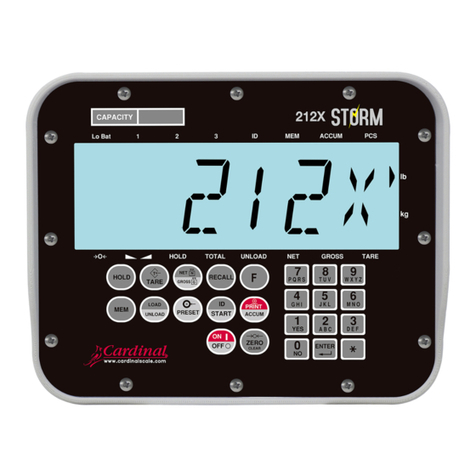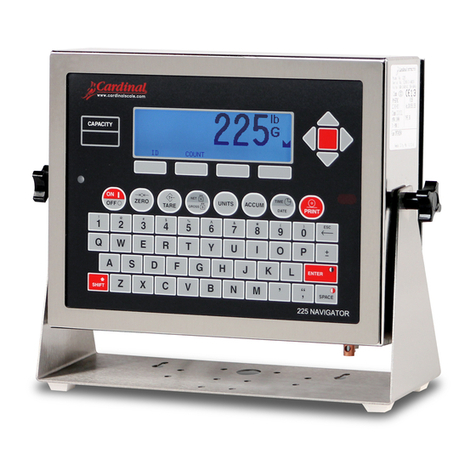
8200-M564-O1 y225 Check Weigher Page 6
MAIN PC BOARD JUMPERS
J4 (PWC1-8) and J5 (PWC9-16) – ACTIVE REMOTE OUT JUMPERS
When installed, these jumpers allow the 225 indicator to supply (source) 5 VDC to a solid-state
relay or other load of 200 ohms or greater. To operate from the 5 VDC source, the positive
connection from the relays must be connected to P15 (P16) pins 2 through 9 and the negative
wire from the relays to P15 (P16) pin 10 (GND). See Figure No. 9 for connector P15 location
and Figure No. 10 for connector P16 location.
For completely isolated outputs, J4 (J5) must be open (on one pin only or removed) and the
user must provide 5 to 12 VDC to P15 (P16) pin 1 (+SRC) and a ground return to the load.
The load must still be 200 ohms or greater and P15 (P16) pin 10 (GND) is not connected.
J6 (REMOTE IN) – REMOTE IN JUMPER
When installed, this jumper allows the 225 indicator to supply (source) 5 VDC to a remote input
circuit. Connecting P17 pins 1 through 9 to P17 pin 10 (GND) through a switch will cause the
selected action. See Figure No. 8 for connector P17 location.
For completely isolated inputs, J6 must be open (on one pin only or removed) and the user
must provide 5 to 12 VDC to P17 pin 1 (+SRC) and a ground return to the switch connected
to P17 pin 2 through 9. Note that P17 pin 10 (GND) is not connected.
J1 (AUTO ON) – AUTO-ON JUMPER
When installed, this jumper will cause the indicator to power on automatically whenever power
is applied to the power input connector. If power is lost momentarily and then reapplied, the
indicator will turn on without pressing the ON key.
J2 (TEST) – TEST JUMPER
When installed, this jumper will turn the backlight on, ignoring the BACK LITE= setting.
J3 (8V) – 8V EXCITATION JUMPER
When installed, this jumper allows the 225 indicator to supply 8 VDC excitation voltage when a
remote (external) 12 VDC battery is used to power the indicator. To operate from the 12 VDC
battery, the load cell excitation voltage MUST be set to 8 VDC (J3 closed). Operating with the
load cell excitation voltage set to 12 VDC will result in an unstable weight display.
J7 (+SEN) and J9 (-SEN) – SENSE JUMPERS
If the sense leads are NOT used, you must install jumpers at J7 and J9 (near the P13 and P14
terminal blocks). These jumpers connect the sense leads to the excitation leads. If sense
leads ARE used (as in motor truck scales), these jumpers should be open (on one pin only or
removed).
J8 (DLB) – DEAD LOAD BOOST JUMPER
For very low dead loads (less than 10% of the combined load cell capacity), connect J8, the
DLB (dead load boost) jumper on the printed circuit board.
J10 (GTC) – GND TO CHASSIS JUMPER
When installed, this jumper connects the analog circuit ground to the indicator chassis ground.































